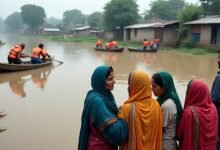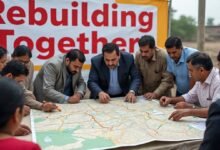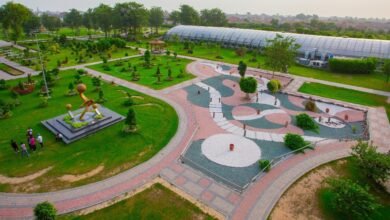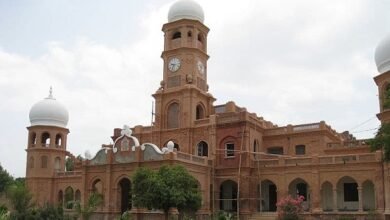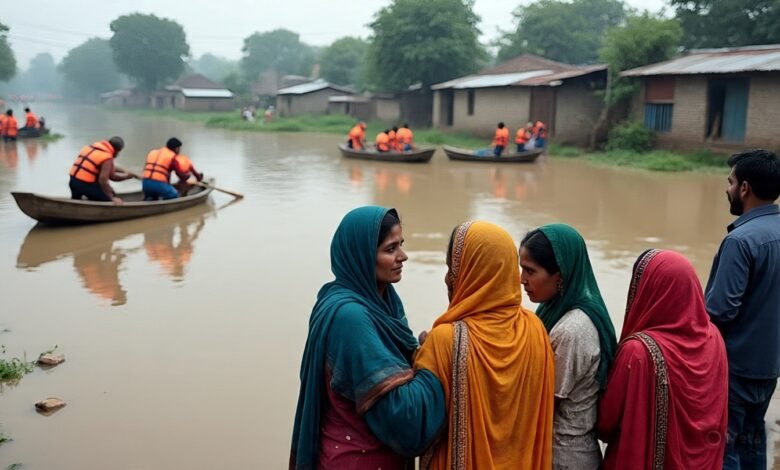
Punjab Govt Initiatives for Flood Control and Rehabilitation
Comprehensive guide to Punjab Pakistan's flood control initiatives, PDMA programs, early warning systems, rehabilitation efforts, and government relief measures for 2025 disasters.
Punjab, Pakistan’s most populous province, has consistently faced the devastating impacts of seasonal flooding, with the 2025 monsoon floods representing one of the most severe natural disasters in recent history. The province witnessed unprecedented inundation affecting over 4.2 million people, displacing families across more than 3,100 villages and hamlets. In response to these recurring challenges, the Punjab government has implemented comprehensive flood control initiatives and rehabilitation programs designed to protect lives, infrastructure, and livelihoods.
Under the leadership of Chief Minister Maryam Nawaz Sharif, Punjab has revolutionized its approach to disaster management through advanced early warning systems, coordinated emergency response mechanisms, and extensive rehabilitation frameworks. The Provincial Disaster Management Authority (PDMA) Punjab, in collaboration with federal agencies and international partners, has established robust protocols that combine modern technology with traditional flood management practices. These initiatives represent a paradigm shift from reactive emergency response to proactive flood prevention and preparedness, ensuring that vulnerable communities receive timely assistance while building long-term resilience against future climate-related disasters.
Provincial Disaster Management Authority (PDMA) Punjab: The Cornerstone of Flood Control
Organizational Structure and Mandate
The Provincial Disaster Management Authority (PDMA) Punjab serves as the primary institutional framework for coordinating flood control initiatives across the province. Established under the National Disaster Management Act, PDMA Punjab operates through a comprehensive network of district-level offices, ensuring rapid response capabilities in all 36 districts of the province.
Key responsibilities of PDMA Punjab include:
- Developing and implementing comprehensive disaster management policies
- Coordinating with federal agencies including the National Disaster Management Authority (NDMA)
- Establishing early warning systems for flood-prone areas
- Managing emergency response operations during active flooding
- Overseeing post-disaster rehabilitation programs
- Conducting regular risk assessments and vulnerability mapping
Provincial Emergency Operations Center (PEOC)
The Provincial Emergency Operations Center (PEOC) represents the nerve center of Punjab’s flood management strategy. Operating 24/7 throughout the monsoon season, PEOC facilitates real-time coordination between provincial line departments, district administrations, and federal agencies.
PEOC’s advanced capabilities include:
- Real-time monitoring of river levels and meteorological conditions
- Coordination with irrigation departments for strategic water releases
- Management of evacuation procedures in high-risk areas
- Resource allocation and deployment of rescue teams
- Communication with international partners and aid organizations
Advanced Early Warning Systems and Technology Integration
Punjab Floods Disaster Management System (PFDMS)
In collaboration with the Punjab Information Technology Board (PITB), PDMA Punjab has developed a sophisticated web-based disaster management system that revolutionizes flood preparedness. The system, based on open-source Sahana software, provides:
Comprehensive Data Management:
- Secure data logging for district officials and relevant departments
- Integration with livestock, irrigation, agriculture, health, and Rescue 1122 systems
- Automated reporting templates with live dashboard updates
- Real-time assessment of flood extent through satellite imagery from SUPARCO
Public Interface Features:
- Publicly accessible weather and flood forecasts
- Real-time flood warnings for vulnerable communities
- 24/7 helpline (1129) management system
- Mobile applications for post-flood damage assessment
SMS-Based Early Warning System
Punjab’s early warning system incorporates an advanced SMS alert mechanism that directly communicates flood threats to residents in vulnerable and low-lying areas. This system ensures that:
- Timely notifications reach communities before severe inundation occurs
- Evacuation orders are communicated effectively to remote areas
- Weather advisories and safety instructions are disseminated rapidly
- Emergency contact information is readily available to affected populations
Emergency Response and Rescue Operations
Coordinated Multi-Agency Response
The Punjab government’s emergency response framework involves seamless coordination between multiple agencies to ensure comprehensive flood management:
Primary Response Agencies:
- Pakistan Army – Mass evacuations and logistics support
- Rescue 1122 – Search and rescue operations
- Civil Defence – Emergency shelter management and supply distribution
- Punjab Police – Security and traffic management
- Pakistan Navy – Water-based rescue operations in severely affected areas
Rescue and Relief Statistics (2025 Floods)
The scale of Punjab’s emergency response during the 2025 floods demonstrates the effectiveness of coordinated disaster management:
- 300,000 people evacuated within 48 hours during peak flooding
- 12,427 individuals rescued by boat operations in a single 24-hour period
- 40,000 people accommodated in relief camps across affected districts
- Over 1.3 million people displaced and relocated to safer areas
- Helicopter and drone operations conducted for hard-to-reach areas
Comprehensive Rehabilitation Programs
CM Punjab Flood Relief Program 2025
Chief Minister Maryam Nawaz Sharif launched the comprehensive CM Punjab Flood Relief Program 2025, which provides systematic support for flood-affected families through:
Registration and Verification Process:
- CNIC-based registration at relief camps for transparent service delivery
- NADRA database verification to prevent fraud and ensure authentic beneficiaries
- Family composition assessment including livestock and property details
- Priority assistance for vulnerable groups including widows, orphans, and disabled individuals
Relief Services Provided:
- Emergency shelter and accommodation in fully equipped relief camps
- Daily provision of nutritious meals and clean drinking water
- Medical treatment and healthcare services
- Financial assistance for immediate needs and rehabilitation
- Livestock protection and veterinary care
- Educational support for displaced children
Financial Compensation and Support Schemes
The Punjab government has implemented multiple financial compensation programs designed to support long-term recovery:
Electricity Bill Relief Pakistan 2025:
- GST exemptions on electricity bills for flood-affected areas
- Subsidized electricity rates for households in designated flood zones
- Waiver of provincial land taxes for agricultural areas
- Integration with BISP Flood Relief 2025 for direct cash assistance
Agricultural Rehabilitation Support:
- Seed distribution programs for affected farmers
- Livestock compensation for animal losses
- Crop insurance settlements and agricultural equipment replacement
- Technical assistance for soil restoration and land rehabilitation
Infrastructure Development and Flood Prevention
Embankment Strengthening and River Management
Punjab’s long-term flood prevention strategy focuses on structural improvements to river management systems:
River Infrastructure Projects:
- Rehabilitation and strengthening of critical embankments along Sutlej, Ravi, and Chenab rivers
- Construction of spillways and overflow channels for controlled flooding
- Restoration of natural floodplains and wetland areas
- Implementation of anti-erosion measures along vulnerable riverbanks
Federal Collaboration Projects:
- “Flood Protection and Dike Improvement in Southern Indus River” project with JICA
- Asian Development Bank-funded infrastructure rehabilitation initiatives
- Federal Flood Commission (FFC) coordination for National Flood Protection Plan-IV
- International partnerships for technical expertise and funding
Smart Infrastructure and Climate Resilience
The province is investing in climate-resilient infrastructure that can withstand future flood events:
- Multi-hazard resistant design standards for critical infrastructure
- Improved drainage systems in urban and rural areas
- Strategic placement of emergency supply depots
- Enhanced telecommunications infrastructure for emergency coordination
International Collaboration and Funding
Global Partnerships for Disaster Resilience
Punjab’s flood control initiatives benefit from extensive international collaboration:
Key International Partners:
- Japan International Cooperation Agency (JICA) – Technical expertise and funding for flood protection
- Asian Development Bank – Infrastructure rehabilitation and resilience building
- World Bank – Capacity building and financial support
- Turkish Cooperation and Coordination Agency (TIKA) – Emergency relief operations
- United Kingdom – £3.4 million pledge for emergency assistance
Climate Finance and Adaptation Funding
The NDMA’s International Collaboration Wing actively seeks climate finance through:
- Development of bankable resilience projects
- Engagement with international climate funds
- Strategic partnerships with multilateral development banks
- Regional data sharing initiatives for improved flood forecasting
Community-Based Disaster Risk Reduction
Local Capacity Building Programs
Punjab’s approach to disaster management emphasizes community empowerment through:
Training and Awareness Programs:
- Community-level disaster response training
- School-based flood safety education
- Women’s groups engagement in disaster preparedness
- Youth volunteer programs for emergency response
Community Infrastructure:
- Village-level early warning systems
- Community emergency shelters and supply storage
- Local evacuation route planning and marking
- Traditional knowledge integration with modern flood management
Public-Private Partnerships
The Punjab government actively encourages private sector participation in flood resilience through:
- Corporate social responsibility programs for disaster relief
- Private sector involvement in infrastructure development
- Technology partnerships for innovative flood management solutions
- Insurance sector collaboration for comprehensive risk coverage
Lessons from 2025 Floods: Adaptive Management
Operational Successes and Challenges
The 2025 Punjab floods provided valuable insights for improving future flood control initiatives:
Successful Interventions:
- Pre-positioned emergency supplies and equipment at strategic locations
- Effective coordination between federal and provincial agencies
- Rapid deployment of rescue teams and resources
- Successful protection of major urban centers through strategic water diversions
Areas for Improvement:
- Enhanced livestock protection during evacuations
- Improved telecommunications in remote areas
- Faster damage assessment and compensation distribution
- Better coordination with neighboring states for water releases
Technology and Innovation Integration
Punjab continues to invest in technological solutions for enhanced flood management:
- Drone surveillance for real-time flood monitoring
- Satellite imagery analysis for damage assessment
- Mobile applications for field data collection
- Artificial intelligence for flood prediction and early warning
Future Roadmap and Strategic Vision
Long-term Flood Management Strategy
The Punjab government’s vision for comprehensive flood control includes:
Short-term Goals (2025-2027):
- Complete rehabilitation of flood-damaged infrastructure
- Establishment of additional emergency operation centers
- Enhancement of early warning system coverage
- Strengthening of community-based disaster preparedness
Medium-term Objectives (2027-2030):
- Implementation of basin-wide flood management strategies
- Development of climate-resilient agricultural practices
- Integration of traditional knowledge with modern technology
- Establishment of regional cooperation mechanisms
Long-term Vision (2030-2035):
- Achievement of flood-resilient communities across Punjab
- Complete integration of climate adaptation in development planning
- Establishment of Punjab as a model for disaster-resilient development
- Sustainable financing mechanisms for ongoing flood management
Climate Change Adaptation and Mitigation
Recognizing the increasing frequency and intensity of extreme weather events, Punjab’s climate adaptation strategy focuses on:
- Ecosystem-based adaptation through wetland restoration and afforestation
- Climate-smart agriculture to reduce vulnerability of farming communities
- Green infrastructure development for natural flood management
- Community-based adaptation programs for local resilience building
Conclusion
The Punjab government’s comprehensive flood control and rehabilitation initiatives represent a transformative approach to disaster management that combines immediate emergency response with long-term resilience building. Through the leadership of Chief Minister Maryam Nawaz Sharif and the coordinated efforts of PDMA Punjab, the province has developed robust systems that protect millions of vulnerable citizens while building adaptive capacity for future climate challenges. The integration of advanced technology, international partnerships, community engagement, and innovative financing mechanisms demonstrates Punjab’s commitment to creating a flood-resilient future. As climate change continues to intensify extreme weather patterns, Punjab’s proactive approach to flood management serves as a model for other flood-prone regions, showcasing how government initiatives can effectively bridge the gap between emergency response and sustainable development while ensuring that no community is left behind in the face of natural disasters.
